The electronic sound level meter adopts a wall-mounted fixture design, which can be easily installed on the wall without the need for an additional desktop or space to place it. The measurement is accurate to the digit, which can effectively detect the noise in the environment.
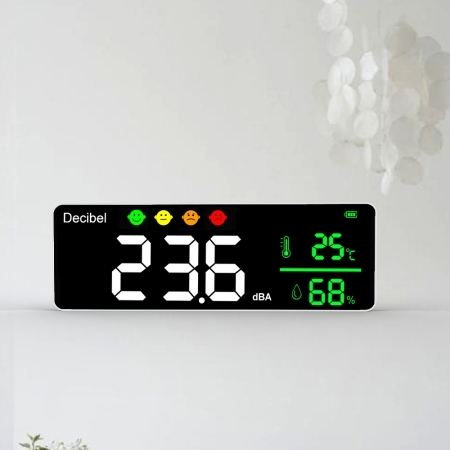
Fully Functional
- Two temperature settings are available: Fahrenheit (℉) and Celsius (℃).
- It has three-in-one functions of sound pressure level, temperature, and humidity to meet various usage needs.
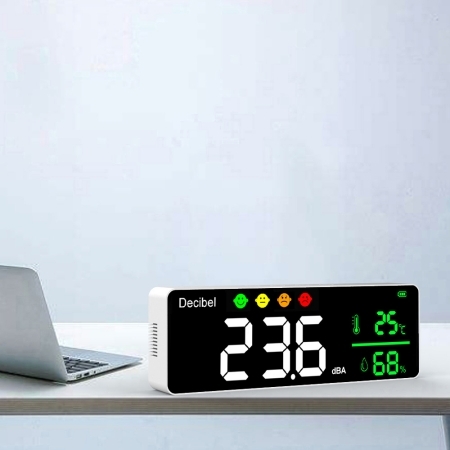
Quality Assurance
- LCD high-definition colorful display, easy to read data.
Built-in rechargeable lithium battery, longer standby time.
Wall-mounted design saves space and has a decorative effect.
Applications
A sound level meter is a device used to measure sound intensity. It is widely used in many fields such as environmental monitoring, industrial production, building design and construction, traffic management, occupational health and safety, etc. Measuring the sound intensity in different areas, helps planning departments understand and control urban noise pollution, and also provides data support for traffic planning and noise control. It is used to detect the noise generated by medical equipment during operation to ensure that the noise of medical equipment will not interfere with and harm patients and medical staff. It is used to detect the noise generated by fire-fighting facilities during operation to ensure that the noise of fire-fighting facilities will not interfere with and harm the surrounding environment and personnel. In times of crisis, it can promptly and effectively sound the alarm to guide people to escape.

Environmental Monitoring

Fire Fetection
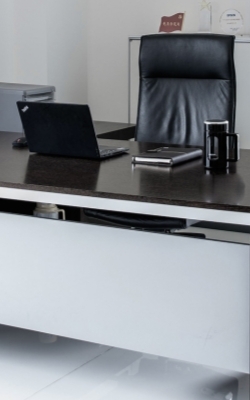
Research and Education

Architectural Acoustics
| Model | SISCO-SLM-DM1306 |
| Input Voltage | DC 5V 1000mA |
| Measuring Range | 30~130dB |
| Accuracy | ±1.5dB |
| Frequency Range | 50Hz ~ 8.5kHz |
| Resolution | 0.1dB |
| Display Method | LED Screen display |
| Atmospheric Pressure | 86Kpa ~ 106Kpa |
| Sampling Time | 1.5 seconds |
| Concentration Unit for Decibel | dBA |
| Detection Temperature | -10℃ ~ 50℃ |
| Temperature Accuracy | ±1.0℃ (0℃ ~ 40℃) |
| Relative Humidity | 20% ~ 85% |
| Humidity Accuracy | ±5% |
| Storage Temperature | -10℃ ~ 60℃ |
| Detection Method for Decibel | Condenser microphone |
| Power Source | 2000 mAh Lithium battery |
| Weight | 350g |
| Dimension | 270mm×90mm×35mm |
Structure Diagram
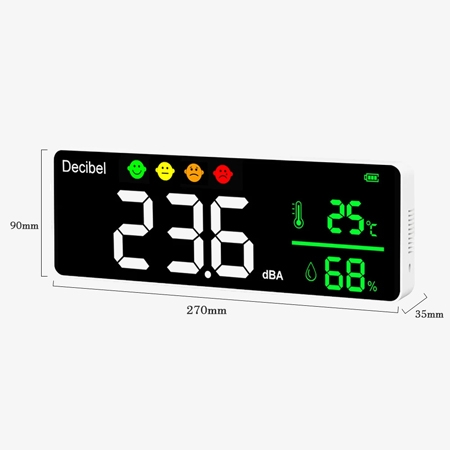
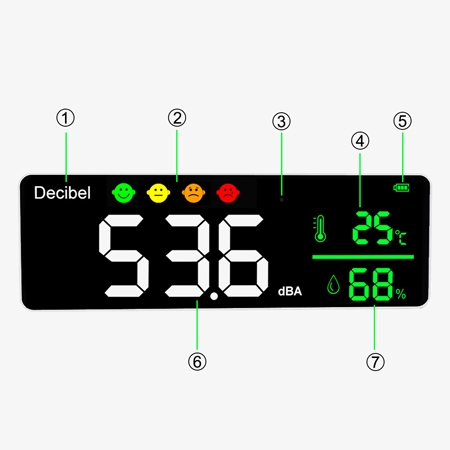
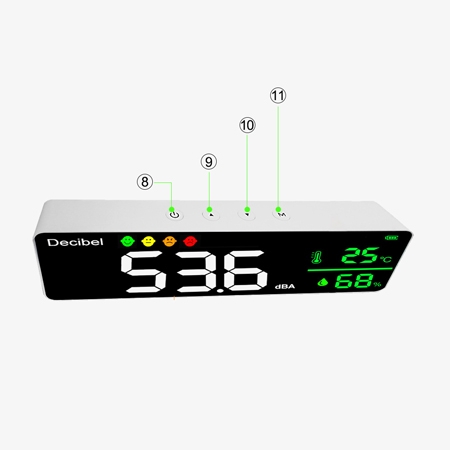
- Decibel meter noise level
- Less than 40dBA (green), 40dB~60dBA (yellow), 60dB~70dBA (orange), more than 70dBA (red)
- Detection sensor port
- Temperature
- Green means full power, yellow means low power, red means no power
- Current decibel value noise value
- Humidity
- Power button, short press to turn on and off (in a quiet room, long press the power button for 5 to 8 seconds in the off state to calibrate, and it will end after 5 minutes)
- Up button, increase the brightness
- Down button, decrease the brightness
- M button, adjust the sampling frequency (slow/medium/fast)
Q1: What is a noise detector?
A1: Noise tester is an instrument used for noise detection and testing in public places such as work sites and squares. Factory noise monitoring Noise pollution is one of the environmental pollutions that have a greater impact. Higher decibel noise can even cause serious damage to people's eardrums and cause deafness. The application of the noise tester can provide the decibel that the noise reaches in order to take relevant measures to control and reduce the noise. The measurement unit of the sound level is decibels. The professional noise tester has a highly sensitive sensor, high accuracy, and a wide range of applications. It can be widely used for noise measurement in various environments. Sound level measuring instrument, collectively referred to as sound level meter.
Q2: Sound level meter working principle
A2: The sound level meter uses a microphone to convert the sound into an electrical signal, and then a preamplifier converts the impedance to match the microphone with the attenuator. The amplifier adds the output signal to the weighting network, performs frequency weighting on the signal (or an external filter), and then amplifies the signal to a certain amplitude through the attenuator and amplifier, and sends it to the effective value detector (or external press Level recorder), give the value of the noise level on the indicator head.
Q3: How big is the decibel scale?
A3: Sound is measured in decibels (dB). Whispering is about 30 decibels, normal conversation is about 60 decibels, and motorcycle engines run at about 95 decibels. Noise above 70 decibels for long periods of time may begin to damage your hearing. Loud noises above 120 dB can cause immediate damage to your ears.
Tips: How to Tell if The Sensitivity of a Sound Level Meter is Appropriate When Buying One?
When buying a sound level meter, telling if its sensitivity is appropriate is a key step. First, be clear about your measurement needs and environment. Different measurement tasks have different requirements for the sensitivity of the sound level meter. Second, the accuracy and frequency of the response of the sound level meter must be checked. Although accuracy and frequency response are not completely equivalent to sensitivity, they are closely related to sensitivity and together affect the measurement performance of the sound level meter. A high-quality sound level meter should provide accurate and reliable sound intensity readings and accurately measure sounds of different frequencies. Generally, the human hearing range is roughly 20Hz to 20kHz, so it is ideal to choose a sound level meter that covers this range. Third, consider the dynamic range of the sound level meter. The dynamic range refers to the range between the minimum and maximum sound intensities that the sound level meter can measure. Finally, you can refer to the accuracy grade and calibration of the sound level meter.
Thank you for buying industrial test and measurement equipment on SISCO.com, all products sold by SISCO and the partner cover a 12 months warranty, effective from the date of receiving the products.
What is covered?
SISCO is responsible for providing free spare parts, and free technical support to assist the customer to repair the defective products until the problem is solved.
What is not covered?
- Product purchased from anyone other than a SISCO store or a SISCO authorized reseller.
- Expendable parts.
- Routine cleaning or normal cosmetic and mechanical wear.
- Damage from misuse, abuse or neglect.
- Damage from use of parts other than SISCO approved.
- Damage from use outside the product’s usage or storage parameters.
- Damage from use of parts not sold by SISCO.
- Damage from modification or incorporation into other products.
- Damage from repair or replacement of warranted parts by a service provider other than a SISCO authorized service provider.
- Damage caused by the application environment not meeting the product usage requirements and the failure to perform preventive maintenance.

